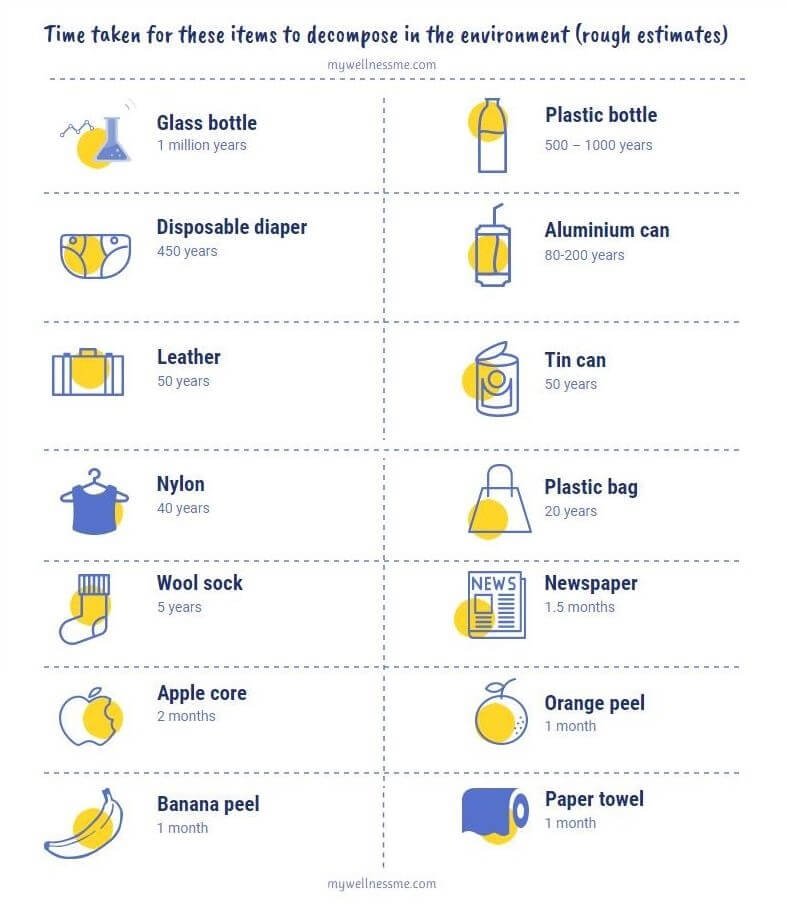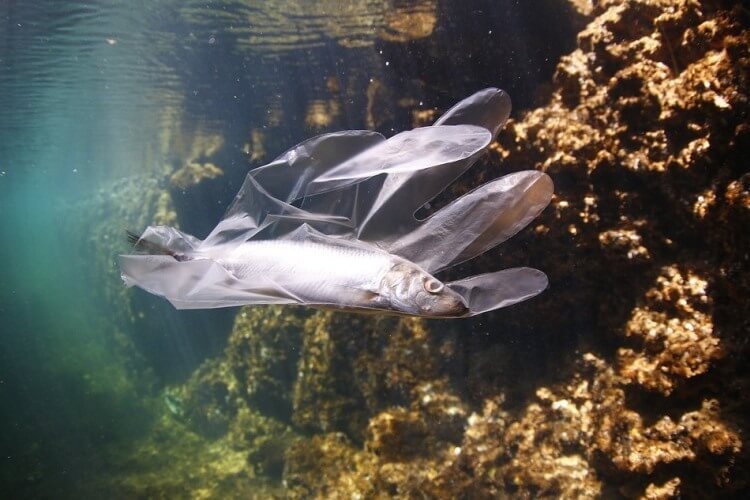“Biodegradable” is a term that manufacturers often use to get our attention; successfully, most of the time. After all, no eco-friendly soul will pass on the opportunity to do something good for Mother Earth.
These smart people are aware of this vulnerable spot and so aim the arrow straight at our soft green center.
It’s hard to say if all have their hearts in the right place. Some will try to exploit technicalities and gray areas. Or maybe they’re just plain confused themselves, even though the likelihood is they’re just being naughty.
So for us, it makes sense to know the answers to some relevant questions, such as:
- What makes an object biodegradable?
- Why do they biodegrade?
- What is the contribution of nature to how things biodegrade?
It’s time to don our Sherlock deerstalkers and try and get to the bottom of all this.
Are All Things Biodegradable?
Mmm… yes?
There is nothing in the world that does not break down when confronted with the elements and the ravages of time.
A sword fashioned from the finest steel in a state-of-the-art kiln will one day turn to dust.
Even the much maligned enemy from the depths of environmental hell – plastic – will eventually go.
In short, everything is decomposable.
Are they biodegradable though?
There are hundreds of definitions of the term. A simple one would be: objects that eventually return to nature through the help of microorganisms and the natural elements.
However, not all leave without toxic traces. And some take a thousand or, in the case of a glass bottle, up to a million years (yes, that’s the estimate!) to decompose.
So, the eco-friendly meaning can be: organic objects that return to nature leaving behind no toxins and in a much shorter time-frame.
At times we also use the term interchangeably with “compostable.” However, they’re not the same, which will we get to later.
Now to the crux of this post: How do things biodegrade?
How Things Biodegrade – The Process
For a product or object to be biodegradable, it must be able to break down into microscopic pieces and be eaten by microorganisms. Ideally this should happen without leaving behind any harmful, toxic trace.
You can say plants, trees and other organic matter are biodegradable. Once dead in their natural environment, they disintegrate and are consumed by bacteria, fungi, and other microbes. The story is the same with food waste or paper.
What happens to objects when they biodegrade?
All living beings have carbon in them. Plants cannot survive without carbon dioxide which they derive from photosynthesis through sunlight. Even the human body has 18.5 percent carbon in it.
For clarity, let’s take the example of plants. When plants die, the carbon in them goes back to nature through a process we know as biodegradation.
However, microorganisms do not immediate gather around the gourmet. The organic material is first decomposed into chomping pieces through the actions of air, sun and other natural factors.
These microorganisms need oxygen (aerobic biodegradation) and light (photodegradation) to be most effective.
Substances disintegrate faster and become easier to consume when exposed to oxygen, and sunlight has a similar effect.
Bacteria, fungi, worms and other germs then digest the matter (bioassimilation).
Temperature is also an important element. Microorganisms tend to reproduce faster when it’s warm; the more their numbers, the quicker the feast disappears off the table.
Once they’ve had their fill, only carbon dioxide is left behind which then goes back into water, atmosphere, or organic matter rich in carbon called humus.
It is this humus, also called biomass that makes the soil rich and ready for new plants to grow. (One of the basic principles of regenerative agriculture is to use residual crop biomass to fertilize the soil.)
What determines the rate of biodegradation?
There are many factors. For instance, if two identical trees fall in different forests, the one that biodegrades quicker is the tree with the best conditions for this action. That is, the right amount of oxygen, temperature, humidity and a wider variety of microorganisms.
Also, the best natural environment for biodegradation is the soil. It’s not that substances do not biodegrade in rivers and seas, just that under water microorganism numbers are lower and conditions less favourable.
But while soil may be the best natural place for matter to biodegrade, the man-made solution, composting, does a more efficient job in terms of time.
So, what’s the difference between biodegradable and compostable?
Before we dive into that let’s look at the following chart that offers information on the rate at which some common substances biodegrade.

Biodegradable vs Compostable
Objects that can be biodegraded in a controlled setting within 180 days are labelled as compostable.
You can either do this at home or, for best results, leave the job to a composting facility. These facilities will ensure that the matter is composted in a close-to-ideal environment that has the right amount of moisture, temperature, and oxygen.
While all compostable things are biodegradable, not all biodegradable things are compostable.
Here are some examples.
A large tree trunk is biodegradable but not necessarily compostable because of its size. It’ll take much longer than six months to fully compost even under the best conditions.
Cooking oil is another good example of what not to compost. Oil and water do not mix and composting requires moisture to work.
Citrus fruit peels and garlic and onion scraps are also best avoided as they can kill off the microorganisms required for biodegradation.
Till now we’ve been largely talking about living organic matter. What about non-living things? Are they biodegradable?
Let’s take the ultimate scourge of all things green and sustainable – the dreaded plastic.
Is Plastic Biodegradable?
Technically speaking, yes.
Nothing is indestructible in the face of nature, even plastic. It’s ironic that something should get such a bad rap that is in reality processed from the easily biodegradable crude oil.
The issue is that once processed, plastic becomes unrecognizable to microorganisms that are probably like, “I ain’t going anywhere close to that abomination.”
Left on its own, a plastic bottle will eventually disintegrate but that will take anywhere between 500 to 1000 years, maybe more.
Let’s take a hypothetical scenario to put that into context. A bottle manufactured in 1521, when most of us still thought the earth was the center of the universe, would be disintegrating this year.
Of course, some modern plastic manufacturers want us to believe that their products are different and made with that honest intention of saving the planet.
There’s a slight problem though.
Consequences of plastic on marine life
The good part is that these “eco-friendly” plastic products will break down into fragments, as promised. The flip side is that the particles contribute to the 12 million tonnes of plastic that annually make it to the ocean.
The consequences are terrible.

Loggerhead turtles mistake the microplastics for jellyfish and eat them, which can lead to intestinal blockages and ultimately starvation.
Likewise, other sea organisms ingest these particles and don’t feel the need to eat any real food, leading to malnutrition besides starvation.
Also, when the microplastics break down, they release toxic chemicals that can interfere with the reproductive capacity of some marine life.
If given a choice between conventional and treated plastic, I would choose neither. But, if you put a shovel to my head, I will go with conventional plastics as you can at least pick them up and have them recycled. (Read about ways to reduce your plastic footprint.)
Anything is better than the landfill.
And taking about landfills…
Do Things Biodegrade in Landfills?
The very nature of landfills, its packed structure, makes it impossible for some things to biodegrade without harming the environment.
Waste requires oxygen to properly biodegrade. Landfill piles choke the air out.
A banana peel, for instance, may well decompose if left on the top of the pile and exposed to all the right elements.
That same banana peel under a pile will decompose too. But the absence of oxygen (anaerobic biodegradation) will invite methane-producing bacteria to the buffet, resulting in the dangerous greenhouse gas instead of carbon dioxide.
What’s your take on how things biodegrade and the dangers of plastic pollution? Let us know in the comments.


6 comments
A chilling but necessary read! Love your handy info-graph too; I thought glass was more friendly than plastic and, while it is in many ways, I had no idea it took so long to decompose! It explains the ancient soda bottles I often find up on the mountain.
I do not quite compost my vegetable scraps, tea leaves, and done leftovers in the conventional sense. I collect them in a bucket and feed them to our chickens. You would be amazed at how quickly an apple core disappears!
Thanks for sharing the biodegrading process and highlighting why it is important to be conscious about what we consume. 🙂
Thanks Jaya. Using leftover as feed is such a cool idea, just another way to put things back into nature. And yes, we must be very conscious of the things we consume. Thanks for your lovely comment xx
This is a really interesting read! Thank you so much for sharing this, I’ve learnt quite a lot from this post Xo
Elle
Thanks Elle, glad you found this informative.
Ooh this is very informative- and eye-opening when it comes to understanding how our habits have a bad effect on the world. Thank you for sharing x
You’re welcome Eleanor. I am glad you found this informative and, yes, there’s a lot we must do to restore the environment.
Comments are closed.